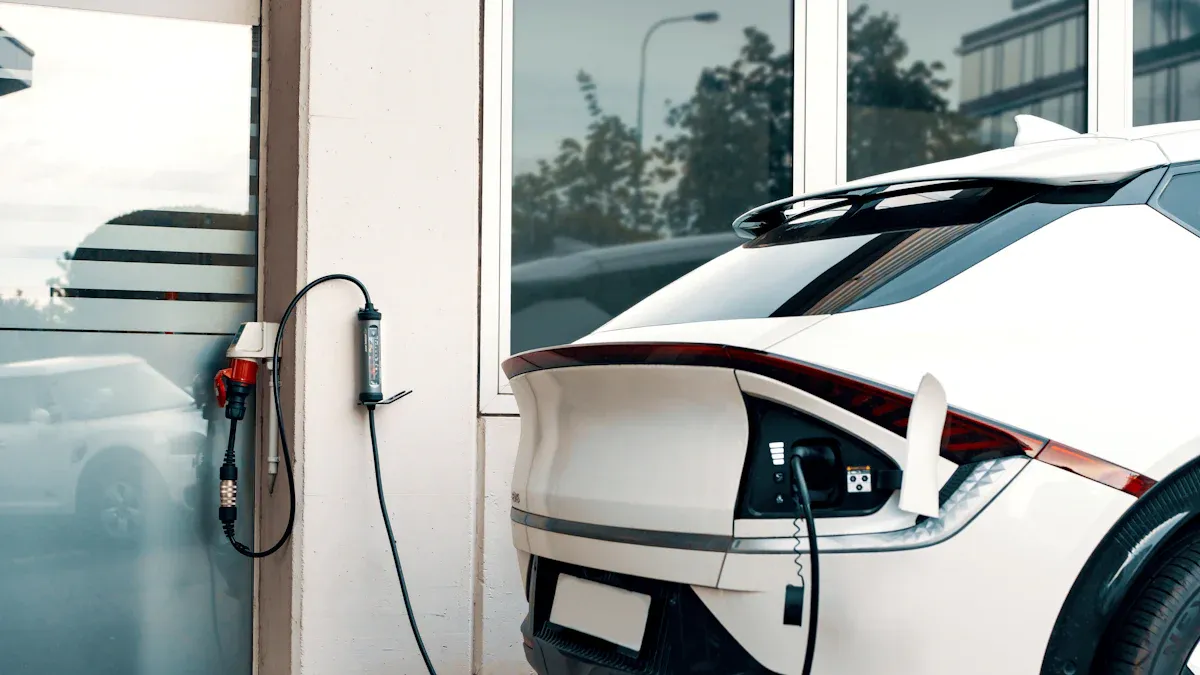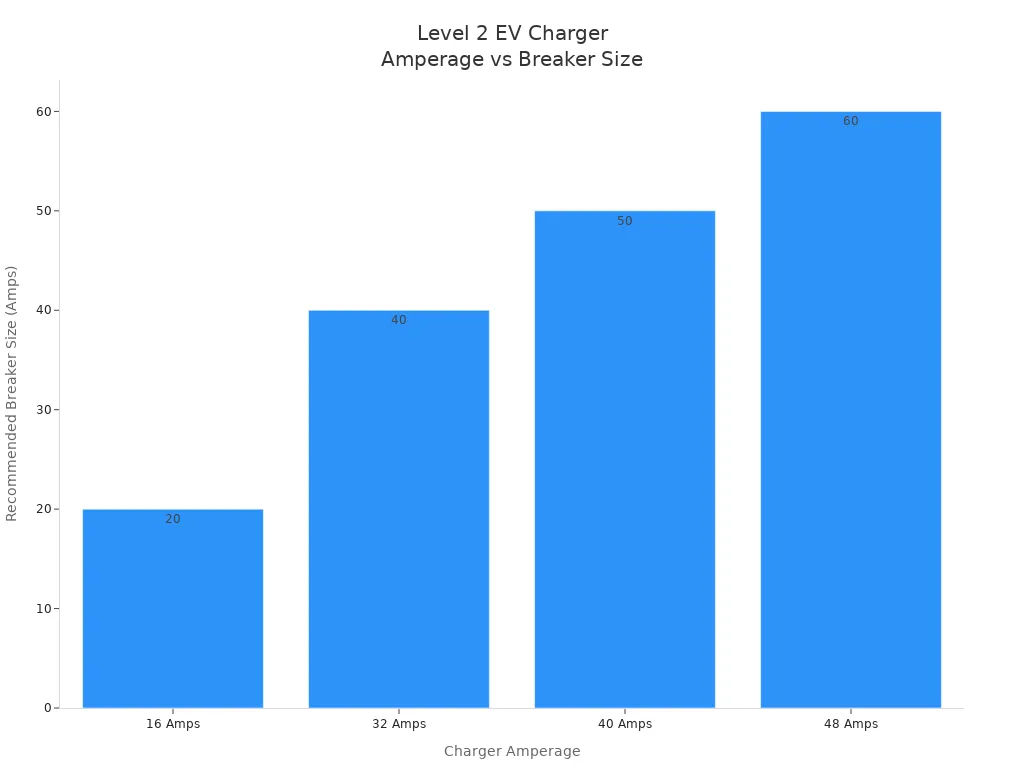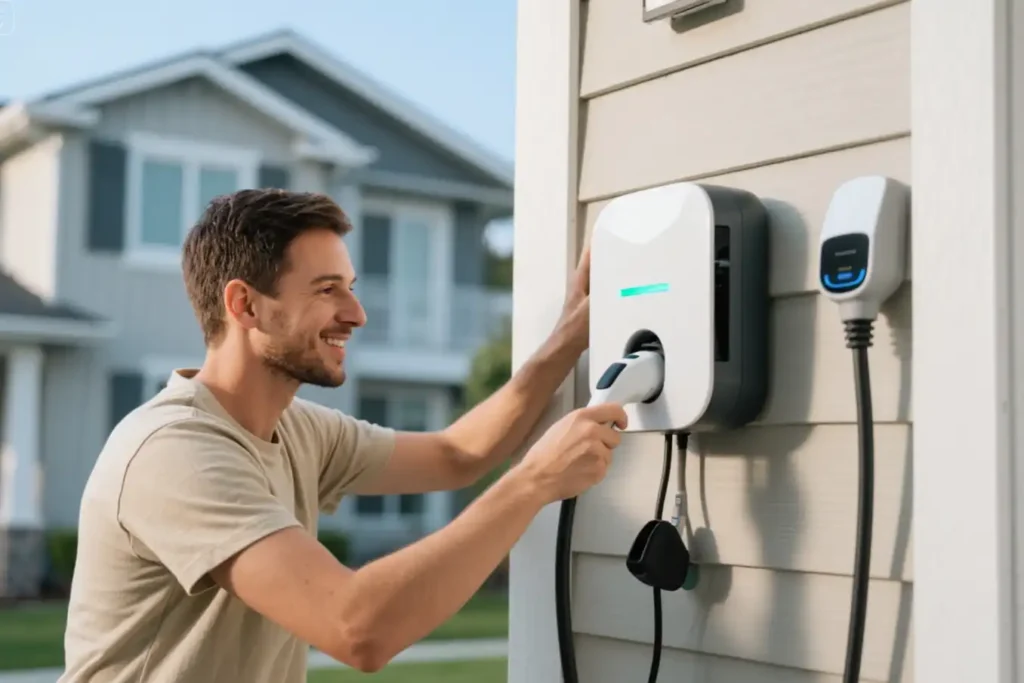You need to check your circuit breaker panel size first before you put in an EV charger. This helps keep your house safe and protects your family. If you skip this step, it can cause fires or hurt your electrical system. You do not need to be an expert to know what your home needs. You can make smart choices and not waste money. Think about how much electricity you use now and if you will use more later.
Key Takeaways
- Check your circuit breaker panel size before you put in an EV charger. This helps keep your home safe and stops electrical problems.
- Level 2 EV chargers need their own circuit. The circuit must have the right breaker size and wire thickness. This helps stop fires and keeps breakers from tripping.
- Follow the National Electrical Code rules. Hire a licensed electrician to make sure your setup is safe and legal.
- Think about what you might need later. Upgrade your panel or add a sub-panel if you want to use more devices. This can help you avoid expensive repairs.
- Use load management devices to control how much power you use. If you cannot upgrade your panel, these devices can save money and stop overloads.
Panel Size Basics

What Is a Circuit Breaker Panel?
You use your circuit breaker panel every day, even if you do not see it. This metal box is usually in your garage or basement. It is the main spot for your home’s electrical system. Power lines from the street connect to your home’s wires here. Inside the box, there is a main breaker and smaller breakers. You also see bus bars, neutral bars, and ground bars. Each breaker sends electricity to a certain part of your house. If there is too much electricity or a problem, the breaker shuts off power. This helps stop fires or damage. You can control your home’s electricity by flipping a switch.
Tip: Always know where your circuit breaker panel is. You might need to turn off power fast in an emergency.
Why Panel Size Matters
You need to check your circuit breaker panel size before adding big appliances like an EV charger. The panel size uses amps to show how much electricity your home can handle safely. Most newer homes have panels with 100 to 200 amps. Older homes may have smaller panels that cannot support new devices.
If you put in an EV charger and your panel is too small, breakers may trip a lot. Lights might flicker or there could be electrical fires. You also need space in the panel for new breakers. Many panels are already full, so it is hard to add more circuits. Here is why panel size is important:
| Reason | Impact |
|---|---|
| Safety | Stops overloads and fire risks |
| Code Compliance | Follows local electrical rules |
| Reliability | Keeps power steady for all devices |
| Future-Proofing | Lets you add new things later |
Think about how much electricity you use now and what you might need later. If your panel cannot handle more, you may need to upgrade or add a subpanel. Getting help from a licensed electrician and doing load calculations can keep your home safe and save money.
Circuit Breaker Panel Size for EV Chargers

Level 2 Charger Requirements
When you plan to install a Level 2 EV charger, you need to know why the right circuit breaker panel size is so important. Level 2 chargers use 240 volts and draw much more power than a standard outlet. Most Level 2 chargers need a dedicated dual-pole circuit. This means you cannot share the circuit with other appliances. The National Electrical Code (NEC) says you must size the circuit and breaker at least 125% of the charger’s maximum current. This rule helps prevent overheating and keeps your home safe.
- A 32-amp charger needs a 40-amp breaker.
- A 40-amp charger needs a 50-amp breaker.
- A 48-amp charger needs a 60-amp breaker.
- Some 50-amp chargers require a dedicated 70-amp circuit.
If you ignore these requirements, you risk tripping breakers, damaging your charger, or even causing a fire. You also need to make sure your circuit breaker panel size can handle the extra load. Many older homes have 100-amp panels, which may not support a Level 2 charger. Modern homes with 200-amp panels usually have enough capacity.
Note: Always check if your panel has enough space and amperage before installing a new charger. This step protects your home and your investment.
Here is a table that shows why the right breaker size matters for different charger types:
| Charger Amperage | Recommended Breaker Size | Explanation |
|---|---|---|
| 16 Amps | 20 Amps | Prevents breaker trips, follows 125% rule |
| 32 Amps | 40 Amps | Common for home chargers, adds safety margin |
| 40 Amps | 50 Amps | Needed for higher current, avoids overheating |
| 48 Amps | 60 Amps | Dedicated high-amperage circuit required |

NEC Code and Safety Standards
You need to follow the NEC code for every EV charger installation. The 2023 NEC update makes the rules even clearer. If your charger draws more than 16 amps or uses more than 120 volts, you must use a dedicated branch circuit. Level 2 chargers always meet these conditions. The code also requires you to size the breaker and wires at 125% of the charger’s maximum load. This rule keeps your wiring from overheating during long charging sessions.
- NEC Article 625.41 says you must size overcurrent protection devices and wires for continuous loads at 125%.
- Section 625.50 requires a dedicated branch circuit for high-power EV charging.
- Starting in 2025, new garages and carports must include EV-ready circuits for Level 2 chargers.
- Professional installation and permits are required in most areas.
If you do not follow these rules, you risk electric shock, fire, and insurance problems. Using the wrong outlet, like a dryer plug, can break grounding rules and make your home unsafe. Proper grounding, GFCI protection, and emergency shut-offs are all required by code. These steps protect your family and your property.
Tip: Always hire a licensed electrician who knows the latest NEC code. This ensures your installation is safe and legal.
Wire Gauge and Breaker Sizing
Choosing the right wire gauge is just as important as picking the correct breaker. The wire must handle the charger’s current without overheating. For most Level 2 chargers, you need copper wire, not aluminum. Copper handles heat better and stays reliable over time. The NEC recommends 6 AWG copper wire for 40-amp and 50-amp circuits. If you use a smaller wire, it can overheat and cause a fire. If you use a larger wire, it may not fit the charger’s terminals.
| Charger Amp Rating | Breaker Size | Wire Gauge | Voltage |
|---|---|---|---|
| 30 amps | 40 amps | 8 AWG | 240V |
| 40 amps | 50 amps | 6 AWG | 240V |
| 50 amps | 60 amps | 6 AWG | 240V |
Wire length also matters. Longer wires can cause voltage drop, which slows charging and wastes energy. You should keep voltage drop below 3%. Always use wire insulation rated for heat and moisture. Only use wires and breakers from trusted brands.
Many older homes have 100-amp panels. These panels may not support the extra load from a Level 2 charger. If your panel is too small, you may need to upgrade to a 200-amp panel. This upgrade gives you enough capacity for your charger and other future needs.
- Signs you need an upgrade:
- Frequent breaker trips
- No space for new breakers
- Panel is 100 amps or less
Alert: Never guess wire size or breaker rating. Mistakes can cause fires or damage your EV. Always consult a professional.
Assessing Your Home’s Capacity
Checking Main Panel Amperage
You need to know your main panel’s amperage before you add an EV charger. The main service panel is a gray metal box. It is usually in your garage or basement. This box has the main circuit breaker. The main breaker controls all the electricity in your house. The number on the main breaker shows how much power your home can use. Older homes might have 60 or 100 amps. Newer homes often have 150 or 200 amps. To check your panel’s amperage:
1. Find the electrical meter outside to see your service type. 2. Look for the main service panel inside or outside your house. 3. Open the panel and find the main breaker or fuse block. 4. Read the amperage number on the main breaker. 5. Make sure you are checking the main panel, not a subpanel.
Tip: Always turn off the power before you open the panel. This keeps you safe.
Evaluating Existing Electrical Load
You must know your current electrical load so you do not overload your system. Every appliance in your house adds to the total load. Big appliances like ovens, dryers, and HVAC systems use the most power. Experts say you should only use 60% to 80% of your panel’s total power. For example, a 150-amp panel at 240 volts gives 36,000 watts. You should not use more than 28,800 watts.
| Appliance/Load Type | Contribution/Factor Details |
|---|---|
| Fixed Appliances | Dishwasher, microwave, disposal; use 75% demand factor if more than four installed |
| General Lighting Loads | Based on square footage, not including garages or unfinished spaces |
| Small Appliance Circuits | Must have enough circuits to pass inspection |
| Continuous Loads | Devices running 3+ hours (like EV chargers) must be multiplied by 125% |
| Permanently Connected Loads | Includes appliances fastened in place, such as HVAC or dryers |
Adding up your total load can be hard. You need to add the wattage of all your appliances. Then you must change this number to amps. Mistakes can be dangerous. You should hire a licensed electrician to do a load calculation. This makes sure your circuit breaker panel size can handle a new EV charger.
Planning for Future Needs
You should think about future electrical needs when you plan for an EV charger. Many old homes with 100-amp panels cannot handle new appliances and EV charging. A 200-amp panel gives you more room for upgrades. You might want to add solar panels, a second EV charger, or a pool later. Planning ahead helps you avoid expensive repairs and keeps your home safe.
- Check if your panel has space for new breakers.
- Upgrade your panel if it is old or almost full.
- Think about smart panels or load management devices to share power.
- Install bigger circuits now for future EVs or faster charging.
- Use smart chargers to watch and schedule charging at off-peak times.
- Add surge protection and GFCI outlets for better safety.
- Ask a licensed electrician to make sure your upgrades follow code and protect your investment.
Planning for future upgrades saves money, stops overloads, and keeps your home ready for new technology.
Solutions for Insufficient Panel Size
Panel Upgrades
Sometimes your main electrical panel is too small. You may need to upgrade it for an EV charger. Upgrading gives your home more power. It lowers the chance of overloaded circuits. It also helps you follow local codes. You should upgrade if your panel is under 200 amps. You should also upgrade if it is older than 25 years. Outdated fuse boxes are another reason to upgrade. Upgrading protects your home insurance and your EV.
| Upgrade Type | Estimated Cost Range |
|---|---|
| Upgrade from 100-amp to 200-amp | $1,500 to $4,000 |
| Electrical service upgrades | $2,000 to $5,000 |
| Replacing fuse box with breakers | $1,500 to $3,500 |
| Full home rewiring (if needed) | $4,000 to $15,000 |
Most upgrades take 4 to 8 hours for an electrician. You get better safety and more circuits. You also feel better about future needs.
Sub-Panels
If your main panel is full, you can add a sub-panel. A sub-panel is a smaller box that connects to your main panel. It gives you extra space for new circuits like an EV charger. You do not need to replace your whole panel. This works if your main panel has enough total power but not enough slots.
- Sub-panels help you control power better.
- They make future upgrades easier.
- You avoid crowding your main panel.
- You can add more circuits for big appliances later.
If your main panel is old or almost full, you may still need a full upgrade. Always pick a sub-panel that fits future needs.
Load Management
You can use load management if you cannot upgrade your panel. These smart devices watch your home’s power use. They change EV charging to stop overloads. Load controllers or smart panels keep charging safe. They pause or slow charging when your home uses lots of power.
Tip: Load management is a cheaper way to add an EV charger. You do not need big electrical changes. You can also set charging times for off-peak hours. This helps lower your energy bills.
Hiring a Licensed Electrician
Always hire a licensed electrician for EV charger work. Licensed experts know the newest codes and safety rules. They do correct load checks and get permits. They make sure your installation passes inspection. Unlicensed work can cause fires, insurance problems, and legal trouble.
Alert: Unlicensed work puts your home and family in danger. Always check for a license before starting any electrical job.
You should look at your electrical panel before you put in an EV charger for a few important reasons. If your panel is big enough, you will not have overloads or breaker trips. This also helps stop fires. A licensed electrician can check your panel and do a load calculation. They make sure your setup follows the rules. If you upgrade your panel now, your home will be ready for new electric devices later. This keeps your investment safe.
Always talk to a licensed electrician. This helps keep your home safe and makes sure your EV charger works well.
FAQ
Why should you check your panel size before installing an EV charger?
You need to check your panel size so you do not overload your system. This helps stop fires and keeps your house safe. It also helps you follow electrical codes. If you check first, you can avoid expensive repairs later.
Why do electricians recommend a 200-amp panel for EV chargers?
A 200-amp panel gives you more room for your EV charger. You can add more appliances in the future. You will not trip breakers as often. Electricians know this size works for most homes today.
Tip: If you upgrade now, you save money and avoid problems later.
Why can’t you use an existing dryer outlet for your EV charger?
Dryer outlets are not safe for EV charging. You need a special circuit just for your charger. Using the wrong outlet can make things overheat. It can also make your insurance not work.
Why does the National Electrical Code require a dedicated circuit for EV chargers?
The NEC wants to keep homes safe from fires. A dedicated circuit gives your EV charger enough power. Other appliances will not be affected. This rule helps protect your home and your money.
Why should you hire a licensed electrician for EV charger installation?
A licensed electrician knows all the safety rules. They make sure your charger is installed the right way. Your home will be safe and pass inspection. You also avoid fire risks and insurance problems.
See also
How to Choose the Right Circuit Breaker for Your Electric Vehicle Charging Setup
How to safely replace the circuit breaker with power on
What Makes Type B RCD Essential for EV Chargers?
What Happens If Your Electric Vehicle Charger Lacks Surge Protection
What You Need to Know About Commercial EV Charging Costs



